
Trivision - Guide to buying Eyewear for Triathlons
Which are the best swimming goggles and sports sunglasses for Triathlons?
With the World Triathlon series taking place in June just down the road from us in Leeds, representing the pinnacle of triathlon competition in the UK and half our office taking part albeit not in the elite class, we have provided a feature and review on what you should consider when buying eyewear for triathlons. This has been split into two parts, goggles and sports sunglasses.
SWIMMING GOGGLES FOR TRIATHLONS
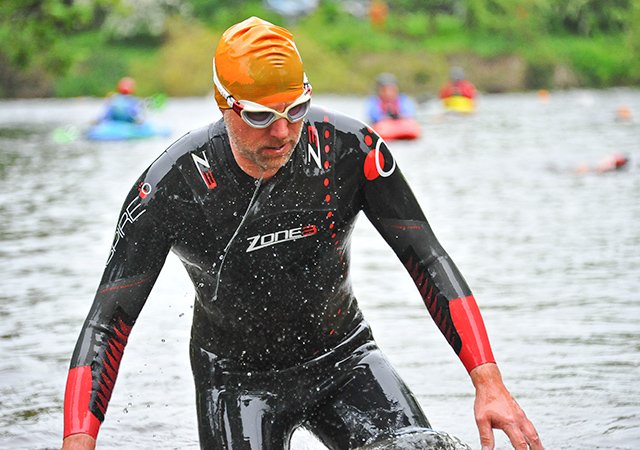
Whether or not you are swimming in open water or in the pool, goggles are an essential part of your kit just like your swim suit or triathlon wetsuit. Where your tri suit will protect your modesty, make you more streamline and keep you warm, your goggles are going to help you more than you can imagine, particularly in an open water environment.
Your vision is perhaps the most important sense, and when it is degraded it can create a chain of events that increase stress levels that affect your performance during a race. Poor vision created by water ingress due to having leaky seals, lenses that are too dark or light for the conditions or lenses that fog up during a race create anxiety and stress. This will distract you from focusing on the most important aspects of your race such as your pace, rhythm, your position in relation to other competitors and the next buoy. If you can’t see the next buoy you are not going to make the most direct line to it. If your vision is blurred, you are not going to be able to effectively draft another swimmer. If you have leaky seals, at some stage you are going to have to deal with it. It is much better to enter the water knowing that you have the right kit to do the job. Below we have attempted to provide a definitive guide to choosing the right prescription and non-prescription goggles to optimise your vision for your triathlon.
What to look out for when buying swimming goggles for your triathlon
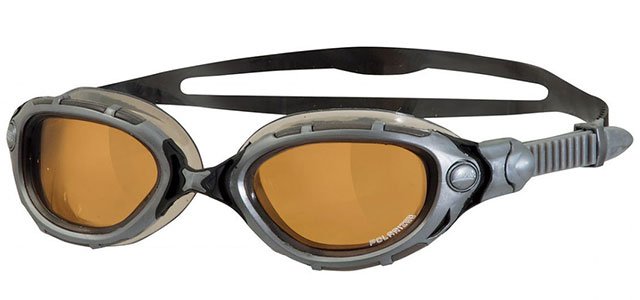
Polarised and Tinted Lenses (mainly for the open water swimmer)
Polarised lenses work by eliminating the horizontal component of light while allowing through vertical light which is useful to the human eye - it helps us see! Horizontal light simply creates glare which can be often seen on a sunny day on water surface or reflected from a shiny surface. Regular non-polarised tinted sun lenses indiscriminately filter all light whether it is horizontal or vertical. Glare is dampened, but not eliminated. More importantly, by filtering all components of light, visual acuity is diminished. However, glare only becomes an issue when the sun altitude is between 30 and 60 degrees and as many open water triathlons start early in the morning, and the fact that you are swimming where the angle from the horizon is not going to affect you, it is debatable whether you need to pay the extra cost for them.
The Zogg Predator Flex goggles (above) is a fantastic goggle. There's a reason they are named in the 220 Triathlon Magazines Best Buy. They are solid, high quality frames with polarised tints (for those who don't want polarised tints there are other options). Although these are mainly for open water swimming, the tints are not very dark meaning you could still use them in low light or in an indoor pool. The large curved lenses give you a better field of view than your average frame. Not only does it have an excellent design but its nosepiece has a 4 way flex technology which creates a better, more secure fit for you.
Click Here for a List of other Polarised Swimming Goggles
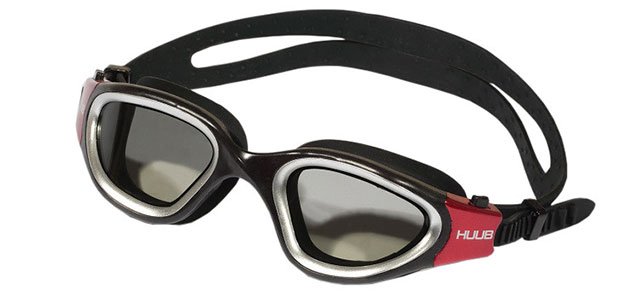
Mirrored Lenses
Whereas polarised lenses work across all wavelengths of light to cut glare, Mirrorlenses work by reducing the overall brilliance of light across certain wavelengths dependent on the colour of the mirror coating, reflecting light away from the eye. Therefore stopping the eye from being damaged by sunlight or glare. They are not as effective as polarised lenses but are cheaper, cosmetically more attractive for certain people and better than polarised lenses in certain situations.
The Huub Aphotic Swimming Goggles(left) are another of 220 Triathlon Magazine Best Buy which they said the "underwater clarity and vision is the best we've witnessed" These cost a little more than the Predator Flex but they do give you extra. They come with a mirror smoked lens that has a photochromic filter with lens cat.1-3 meaning they are perfect for all light conditions. This is also a reason they are a must have in your kit bag for racers or triathlon competitors (in fact the first couple that we got in were snatch up by our resident triathlon racers). They have wide curved lenses that give you a better field of view than your normal goggles and the soft frame and gasket keep them firmly in place.
Click here for a list of other Mirror Lens Swimming Goggles and Mirror Lens Swimming Goggles with Polarised Tint.
Photochromic Lenses (best for outdoor swimmers)
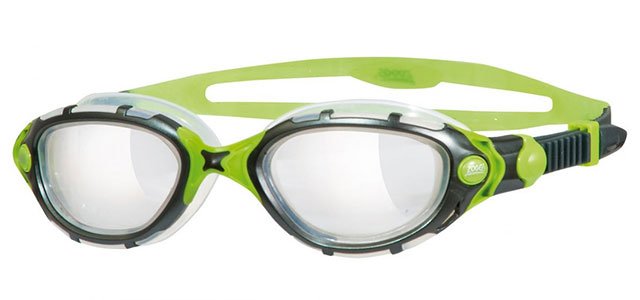
Photochromic lenses are excellent for those that swim in unpredictable weather conditions or in varying light conditions. They are a state-of-the-art, high contrast, light reactive lens that changes lens tint density with the changing light conditions providing comfortable vision whatever the light intensity.
The Huub Aphotic Swimming goggles (above) is a good example, and the Zogg Predator Flex with Photochromic Lenses (left) is a great alternative with a solid, robust and high quality feel to the frame. The photochromic lenses go from cat. 0-2 which means they lend themselves to swimming both indoors and out.
Key frame features for triathlon swimming goggles that are essential:
- Wide Field of View Goggles (mainly for outdoor swimmers) - this is especially useful if you are an open water swimmer. It provides that extra peripheral vision that is useful in being more spatially aware of your competitors. Just look for googles that have a wider goggle lens or have lenses that are curved at the edges.
- Soft frame and gasket - Important for a comfortable leak proof fit. Look out for flexible rubber of silicone gaskets that provide a good seal.
- Anti-Fog Coating – Eliminates condensation inside the lens. Many goggles don't have this as an option mainly because it is a coating that can't be permanently applied. Once you clean the inside of the lens you will wipe the anti-fog coating off. Better to apply an anti-fog coating before every race. They are not expensive and will maintain clarity of vision. Click here for options.
- Adjustable Strap - Ensure your goggles have a double strap for better grip around your head and that they are easy to adjust. Many quality brands have an adjuster mechanism for easy of adjustment before your race.
- Bright Colours- Ok this one is not essential...I do love bright colours and as someone who's a spectator at triathlon events, when you're watching you can't see who you are meant to be cheering for. If you want to be the one to watch make sure you stand out.
NEED PRESCRIPTION SWIMMING GOGGLES?
Due to the risk of eye infections, irritation and potentially sight threatening conditions, it is not advised to use contact lenses while swimming. The safest option is to use goggles made with your prescription. For more information see advice from the Moorfields Eye Hospital linked here.
You have two different options for prescriptions:
- Buy ready to wear RX prescription swimming goggles - These comes with a range of prescription sphere options and you pick the ones closest to your prescription. They do not take account of your astigmatism which is why on some of our options on this site we ask you to provide your full prescription. That way our optician can ensure you have the optimum solution within the constraints of the prescription lenses available.
- Buy custom RX-able prescription swimming goggles - These are designed to accommodate virtually any prescription. They will provide your exact prescription as you would expect when ordering a normal pair of glasses. These are more expensive than the ones above but give you a better quality of vision. Consider this option if you have a high astigmatism - your Cylinders are greater than +/-2.00
Examples of Ready to Wear Prescription Swimming Goggles:
- Leader Vantage,-This is excellent option for prescription triathlon sunglasses, they include three nose bridge options that are easily clipped between the lenses to provide the perfect fit. In addition, soft PVC eye seals ensure leak-proof performance and the hypo-allergenic silicone head strap is easily adjustable to provide a comfortable fit. These swimming goggles are available with modular lens sphere powers from -8.00 to +8.00 diopters.
- Leader Aquasee Competition- It has a standard bridge fit and adjustable strap. Rx range plano, -2.00 to -6.00 in 0.50 steps, -7.00 and -8.00.
- Gator Competition- These are a great pair for triathlons as they have the mirrored lenses, a slightly wider field of view, UV and Anti-Fog coating, a double silicone strap and three interchangeable nose bridges for a good fit. Rx range plano, -2.00 to -6.00 in 0.50 steps, -7.00 and -8.00.
- Speedo Mariner- This is another pair that are suited to being used in a triathlon. Smoke Polycarbonate Anti-Fog lenses with UV protection, hypo-allergenic silicone eye seals and head strap, moulded silicon split strap for secure fit, adjustable nose bridge to fit a range of face shapes. Lens Powers from -1.50 to -6.00 SPH in 0.50 diopters and -7.00 to -8.00
Examples of Custom Made Prescription Swimming Goggles:
- Leader Blick,- These are hypo allergenic silicon double head strap with pre-tension fitting. The eye gaskets are also silicon with the bridge being made from TPU. It also comes with 3 bridge sizes for a better fit. Prescription lenses available in CR39, Polycarbonate and Trivex.Range +6.00 to -8.00 with opp cyls to 4.00.
- Swan F02 Optical,- This is an outdoor swimming goggle that comes with a cat.3 lens, anti-fog coating and adjustable nose pad. 100% UV Protection - Protects your eyes against harmful UV rays. RX Range - -1.50 to -6.00 in 0.50 steps, -7.00 and -8.00
- Progear H20, - Hypo allergenic (latex free) silicone eyecups and head strap with three interchangeable nose bridge sizes, 17mm, 19mm and 21mm. The prescription lenses supplied in clear CR39, Trivex and polycarbonate. Rx range +6.00 to -8.00 with opp cyls 4.00.
- SeaVision Swimvision 2- These have a tint option and are supplied with a fully adjustable head strap. They goggle lenses can be custom made for your individual vision correction, even for astigmatism. Prescription lenses supplied in clear CR39. Rx ranges +6.00 to -8.00 with opp cyles 4.00.
- Leader xRx,-These are one of the best prescription options for those with high prescription. The lenses are made from impact resistant polycarbonate that provide 100% UV protection from harmful ultraviolet rays. In addition, soft PVC eye seals ensure leak-proof performance and the hypo-allergenic silicone head strap is easily adjustable to provide a comfortable fit.
SPORTS SUNGLASSES FOR CYCLING AND RUNNING

Sports sunglasses are also an essential part of your triathlon kit that are needed to improve you comfort while undertaking the running and cycling leg of your triathlon. As with goggles, the right choice can help to improve your overall performance.
Before querying whether a cheap pair would suffice, consider how much you spend on the rest of your kit and how valuable your eyesight is to you. There has been incredible technological advances in lens designs that are reflected in many modern quality sunglasses. They will enable you to optimise your vision, keep you safe and help improve your performance. For more information on sports vision, click here.
Sports sunglasses provide a number of invaluable functions. In addition to blocking harmful UV rays, they must also prevent wind and dust particles entering the eyes, particularly during cycling phase of the triathlon. Grit and dust particles might not create a significant eye injury but they can make them sore and irritate you during the race. Wind hitting cornea can result in epiphora (overflow of tears onto the face) and blurred vision - especially in contact wearers. Wearing tinted lenses that are too dark or light for the environment and weather conditions can also impair your vision. All these factors can distract you from focusing on your race and impair your performance.
What to look out for when buying sports sunglasses for your triathlon
Lens Material
All our sport sunglasses are made out of Polycarbonate or NXT, these are robust impact resistant materials that will prevent eye injuries.
Tints for sports sunglasses
Below is a summary of the main tint colours used in sports sunglasses for cycling and running.
- Grey- Reduces light intensity without altering the colour of objects. This makes it the most natural colour vision lens but does not enhance contrast. Reduces eyestrain in moderate-to-bright conditions. It is the best choice if subtle colour differences are important to you and is the most popular choice of tint colour for general sun wear.
- Brown- Enhances contrast and depth perception by blocking a larger percentage of blue light than grey lenses. This makes objects appear sharper and are ideal for cycling where judging distance is important. They are more flexible in variable light conditions so are great for bright light conditions, but are also suited to overcast, hazy or foggy conditions and perform well in high glare situations.
- Amber- Amber blocks all or nearly all blue light for superior contrast this gives them the ability to brighten vision on cloudy days or moderate-to-low level light conditions. By blocking blue light, these tints increase contrast and visual acuity, especially against green and blue backgrounds such as grass and sky. They also provide excellent depth perception. It is a good all-around choice if you live in an area with changeable weather patterns.
For a more comprehensive list of tints click here.
Lens Categories
For a guide to how lens categories work click here. Below is an overview of lens categories for triathlon users:
TIP: Many of these frame options are available with interchangeable lenses which are great for training. However, for race day you will need to pick one tint option before the race. If the conditions are variable, one of the best solutions for triathlons will be a brown category 2 tint.
Polarised sunglasses
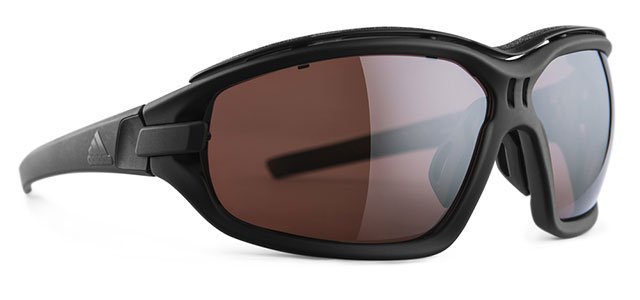
A polarised lens offers the following advantages over non-polarised lenses:
- Improves visual comfort
- Improves contrast and visual clarity
- Reduces eyestrain
- Allows for true perception of colours
- Reduces reflections and eliminates glare
However, most polarised sunglasses are only available in Category 3 tint so only suitable on sunny days.
The Adidas Evil Eye Evo Pro is a good example. It offers cat. 3, Anti-Slip Nose and Temples with wrapped frame & temples – This offers extensive curvature and provides for the widest field of vision as well as optimum protection for the eye area. Great for cycling, it gives you that extra field of vision so you don't have to continuously turn your had. Because the fit so close to the face, it also provides better ergonomic profile. The sunglasses also come with a Sweat Blocker which is a detachable foam insert at the top of the frame that absorbs droplets that might impede visibility. For more polarised triathlon sports sunglasses click here.
Photochromic sunglasses
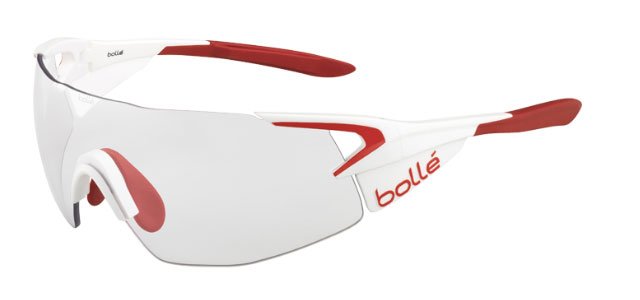
Photochromic lenses as described above are a great option for anyone who wants to buy one frame for several different light conditions and do not want to change the lenses or buy additional sports sunglasses for different conditions. They are ideal in Britain were you may have to go from low light conditions to sunny in the space of an hour. It is worth noting that the better quality photochromic lenses react quick than cheaper ones. Most photochromic sunglasses will also react quicker going from light to dark and take a few minutes to adjust back. So they are not ideal for tracks or roads with lots of quick changing light conditions. Depending on your needs we suggest a category 1-3 or 2-3 lens as these will meet most light conditions.
Photochromic sports sunglasses are ideal for triathlons in the UK as they will optimise your vision for the changing light conditions and avoid any unnecessary compromise. The Bolle 5th Element frame, (left) is a good example. This frame not only has a photochromic lens but has excellent key features in its design from its wrap frame, with an adjustable nose and anti slip temples to its anti-fog and hydrophobic coatings which ensure your vision stays clear and cleaner for longer. To top this off Bolle have now designed a helmet to go with this frame that includes a sunglasses garage. We are currently offering them both as a package. Click here for details. For our full range of photochromic sports sunglasses suitable for triathlons click here.
Interchangeable lenses for sunglasses
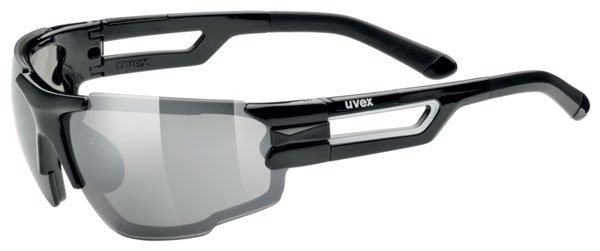
These are an alternative to photochromic lenses. Instead of them changing automatically with the sun, you can change them yourself. It also gives you the option of other tint colours instead of just the one. Great for general cycling, but not as practical in a triathlon race day as you will not have time to change lenses.
The Uvex Sportstyle 112 is a good option to consider. It comes with three lenses, grey, orange and clear. Quick Change Interchangeable Lenses Included - Cat 0+1+3, which allows you to tailor your eye protection to your activities and current conditions. As you can see it has Lens Venting System – Natural front airflow will direct air currents towards the face to prevent fogging. It also includes a Sweat Blocker, which is a detachable foam insert at the top of the frame that absorbs droplets that might impede visibility and anti-slip nose and temple arms to hold the frame firmly on your head.
Key frame features for triathlon sports sunglasses that are essential:
- Wrapped frame & temples – Extensive curvature provides for the widest field of vision as well as optimum protection for the eye area by preventing dust or grit from hitting your eyes. It also provides better ergonomic profile by fitting your facial contours for firm fitting on your face or head.
- Anti-Slip Nose Piece - Ensures maximum comfort and eliminate slippage.
- Adjustable Nose Pads - They help to keep the frames secure on your face and prevent them from sliding down your nose.
- Anti-Slip Temples - Incorporates non slip components, helping to keep the frame securely on your face.
- Sweat Blocker - Includes a detachable foam insert at the top of the frame that absorbs droplets that might impede visibility.
- Lens Venting System – Natural front airflow will direct air currents towards the face to prevent fogging.
- Anti-Fog Coating – Eliminates condensation inside the lens. Although if this doesn't come on your lens you can buy a spray separately. Click here for details.
- Bright Colours - Again maybe not essential but remember how bright the rest of your kit is. Its more fun.
NEED PRESCRIPTION SPORTS SUNGLASSES?
If you need a prescription correction, you are unlikely to be wearing contact lenses while swimming so you will need prescription sunglasses. Fortunately there are now many options for you to choose whether you need single vision, bifocals or varifocal lenses for your sports sunglasses. Below we have highlighted a number of key considerations:
Which lens material should I choose?
We always suggest when choosing glasses or sunglasses for sport that you consider impact resistance lens such as polycarbonate or NXT. Even in situations where you may not be involved in impact sports, unexpected events do occur that are out of your control. Whether it is being hit by a branch while running or falling off your bike on your face, accidents do occur. Wearing impact resistant lenses will not only protect your eyes but also will not break up like other lenses turing an accident into a serious eye threatening injury.
Should I choose a Clip-in or Direct into frame sports prescription sunglasses?
For triathlons where you are likely to be training most days, it is worth investing in a good pair of direct fitting prescription sunglasses. These will give you performance enhancing vision, a wider field of peripheral vision and more accurate depth perception. However, we have highlight the pros and cons of direct fitting v clip-in prescription inserts for sport here.
Which prescription package should I choose?
The most flexible sports prescription sunglasses package for triathlons are photochromic lenses that have a light reactive range from between category 1 to category 3. Our transition lenses start nearly clear so will be effective for cycling in extremely dull days or for reading the menu in a cafe when you are not training quite so seriously. They are also effective in extremely sunny days in Europe providing for all light conditions.
Should I choose single vision, bifocal or varifocal lenses for my sports sunglasses?
It really depends on your prescription and preference. Single vision provides uninterrupted distance vision. If you are young or short sighted they might be fine as you will not need to worry about looking at your speedo or watch close up. At the other extreme, the more older and long sighted you are, the more likely you will need a bifocal or varifocal solution. Bifocals are great for those who have not used varifocals before. They do not need any adaptation, if you tell us they are for cycling we will fit only a small bifocal that will not be noticed unless you look at your speedo, and your distance vision will be uninterrupted.
In the past we only recommend bifocals as most varifocals were of poor quality and provided very restrictive corridors. This necessitated moving your head constantly whenever you wanted to see anything clearly and when moving at speed while cycling caused a 'swimming sensations'. Over the last few years there has been a revolution in varifocal lens design and with todays digital high definition lenses we can virtually design the lens around you. This will ensure wide, uninterrupted distance vision with smooth a transition of increasing power for intermediate and near vision, maintaining minimal distortion in the lower peripheral area of vision.
- Ordering Prescriptions
- Lens Options Explained
- About Glasses
- About Sunglasses
- About the Eyewear Brands
- Eyecare
- Eye Conditions
- Frequently Asked Questions
- Blog
- About Us
- Why Choose Eyekit for your Prescription?
- Varifocal Prescriptions
- Tint Colour Options for Prescription Lenses
- Special Offers
- Guide to Buying Eyewear Online at Eyekit
- Choosing Eyewear for Sport
Latest From Eyekit
Rain Rain Go Away- Why you need a Crystal Vision Coating on your Prescription Glasses and Sunglasses
The snow was short lived but us Brits know that the Winter/ Spring showers have just begun. You know how it starts, you get out your bike or you figure out your hike for the day on the map and
Eyekit’s Top 10 Tips to Help You Keep Your New Year’s Resolution
Every year we make them and every year we try and try but eventually break them. So its time to stop the cycle and (maybe take up...
Our top 5 Eyewear items to Help Your Eyes this Lock Down
We have looked at our top 5 most popular Eyewear items that people needed during the last lockdown that could help you with this...
Veganuary - Can Excluding Animal Products Have an Impact on Your Eyesight?
We often make connections between diet and cardiovascular disease or obesity but we often forget that eye sight and vision loss is also linked to...
Winter Is Here
Here's how you can help out your eyes this winter. THE SUN HAS GOT HIS HAT ON- even in winter You might only think you need your sunnies...








